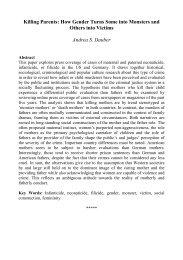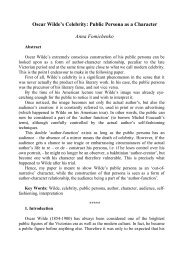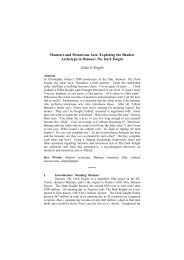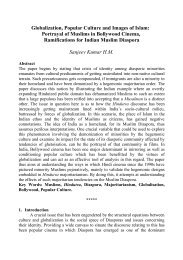“These three avant-garde designers have become an international ...
“These three avant-garde designers have become an international ...
“These three avant-garde designers have become an international ...
You also want an ePaper? Increase the reach of your titles
YUMPU automatically turns print PDFs into web optimized ePapers that Google loves.
esemble each other nor the st<strong>an</strong>dard in Jap<strong>an</strong>. 23<br />
“Despite the fact that all of them share a common heritage <strong>an</strong>d are of the<br />
same generation, these individuals differ startlingly in their creative<br />
output. Issey Miyake is often described as the most optimistic <strong>an</strong>d<br />
forward-looking of them…By contrast Yohji Yamamoto’s revisions of<br />
historical Western dress place him in the “rom<strong>an</strong>tic” faction of today’s<br />
<strong>av<strong>an</strong>t</strong>-<strong>garde</strong>. He often combines recognizable Western silhouettes, such as<br />
the bustle, with unorthodox materials to create the most beautiful of <strong>av<strong>an</strong>t</strong><strong>garde</strong><br />
fashions. Intellectualism is the defining element of Rei Kawakubo’s<br />
work […] In her overriding desire to create fashions that defy<br />
conventional beauty while at the same time redefining what we see as<br />
fashionable, Kawakubo is the quintessential postmodern designer.” 24<br />
In 2003, the Musée des Arts Asiatiques, a small museum in Nice devoted to the art of<br />
China, Jap<strong>an</strong>, India, <strong>an</strong>d Indochina, presented XXIème Ciel: Mode in Jap<strong>an</strong>, displaying<br />
the garments of Yamamoto, Miyake, Kawakubo, <strong>an</strong>d W<strong>an</strong>t<strong>an</strong>abe. The director, Marie-<br />
Pierre Foissy Aufrère, saw in the garments of these makers <strong>an</strong> intrinsic link to <strong>an</strong>cient<br />
Asi<strong>an</strong> cultures, that mysterious quality or “côté magique” found in Jap<strong>an</strong>ese art. 25 She<br />
was met with initial refusal, however, when proposing the idea to the <strong>designers</strong> who<br />
refused to be exhibited on the basis of <strong>an</strong> outdated Orientalism. 26<br />
This exhibition did not provide a historical overview of contemporary Jap<strong>an</strong>ese<br />
fashion or the usual discourse on radical design. Rather, as Patricia Mears, a collaborator<br />
on this project, notes, curators created “a visual story that evoked the beautiful qualities<br />
of Jap<strong>an</strong>ese design from a decidedly Western point of view.” 27 French conceptual artist<br />
Gotscho (whose work often focuses on fashion) designed the exhibition space, placing<br />
the garments in a theatrical display of fashion clichés including the coat rack <strong>an</strong>d top<br />
model. These str<strong>an</strong>ge juxtapositions <strong>an</strong>d lack of contextualizing information perhaps<br />
allowed the garments to speak for themselves as such, highlighting the differences<br />
8

















